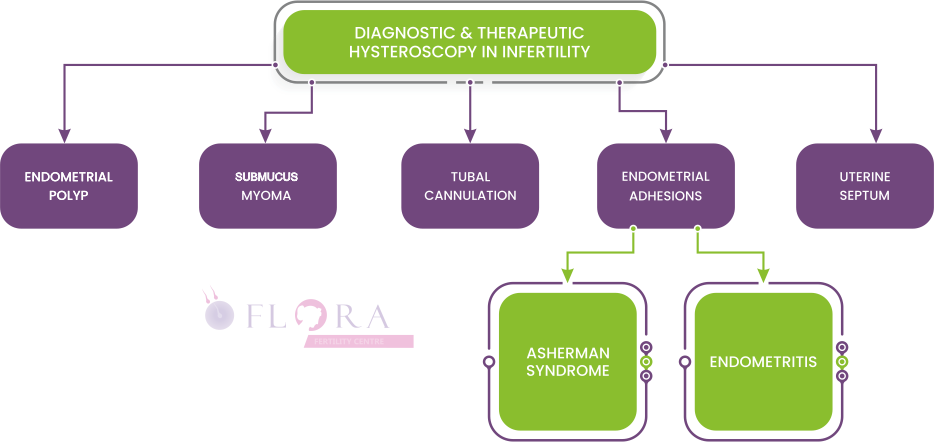What is Hysteroscopy
- Hysteroscopy is a procedure that enables the surgeon to view the internal structures of your uterine cavity without the need for an incision.
- The uterine cavity is examined for any intrauterine pathology and opening of fallopian tubes.
- Removal of polyps or taking a biopsy sample is done during a hysteroscopy procedure.
- It is a minimally invasive procedure which needs short hospital stay and has a faster recovery and no need to take bed rest.
Hysteroscopy for Infertility
- Hysteroscopy is a test done to evaluate the possible causes of infertility.
- Doctor may suggest to undergo hysteroscopy.
- Uterine problems can be the reason behind infertility and repeated miscarriages.
- Uterine polyps or removal of scar tissue done with the help of hysteroscopy increases the chances of conception.
If IVF, advised hysteroscopy may be required to check if womb is healthy enough to carry a successful IVF procedure.
Surgeon can correct the following uterine conditions by performing hysteroscopy:
Removal of Polyps and Fibroids – Enlarged polyps or fibroids cause recurrent pregnancy loss and infertility. These uterine tissue growths can be removed by hysteroscopy.
Locate and remove adhesions – Scar tissue formed in the uterus can cause increased menstrual flow and infertility. With hysteroscopy, the surgeon can locate these adhesions and remove them.
Septum’s – A septate uterus is a deformity of the uterus, which increases the risk of miscarriage. Hysteroscopy is done to remove the septum.
Abnormal bleeding – Hysteroscopy can help to determine the cause of heavy menstrual bleeding and bleeding in between periods. Areas of bleeding found during the procedure are treated using a laser, electrocautery, or surgical removal.
- Surgical procedures performed during hysteroscopy increases chances of pregnancy.
- It is a safe procedure with minimal complications. You can return to your daily activities within one or two days of the surgery.

Hysteroscopy PROCEDURE
- Hysteroscopy surgery is performed a week after your period as it allows a better view of the uterus. Prior to surgery, patient will be given anesthesia.
- The surgeon will insert a hysteroscope, a thin tube with a light and camera into the vagina.
- Hysteroscope allows the doctor to examine the uterine cavity, tubal ostea and if any uterine anomalies.
- Any abnormality is corrected using small instruments.
- Though the procedure is not painful, patient may experience slight cramping.
- The whole process takes 30 minutes, depending on the diagnostic and operative procedures needed to be performed.
Benefits of Hysteroscopy
- It requires a short hospital stay
- Recovery is faster
- Less pain and requires less medication after the procedure
- Avoids any open incision for surgery. If required 1 to 2-days bed rest.
Risks
- Hysteroscopy is a safe procedure and complications are very rare.
- Hysteroscopy complications are like: infection, heavy bleeding, injury to uterus, cervix or bladder, and reactions due to general anesthesia.
- Consult doctor if patient experience any of these symptoms.
Note: –
- It can also help to determine the cause of IVF failure or recurrent pregnancy loss.
- Altogether hysteroscopy has a high success rate that increases the chances of conception and successful IVF.
- Hysteroscopy surgery is a low-risk procedure, and recovery is quick.
- Within 2 days of the procedure, patient can return to normal daily activities.
- Hysteroscopy before IVF can avoid some failed attempts. It increases chances of natural conception or a successful IVF.
